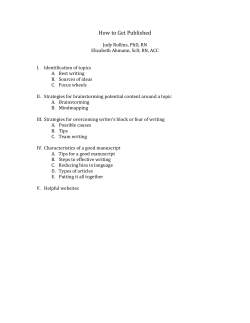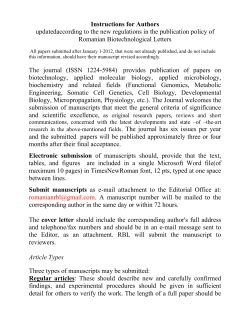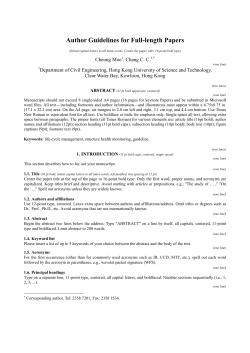
HOW TO PREPARE A MANUSCRIPT ...
HOW TO PREPARE A MANUSCRIPT FOR ELSEVIER PROCEEDINGS The manuscript should be written in English and neatly typed or printed on one side of the paper using double line spacing. Unclear handwritten insertions are not acceptable. The following guidelines should be carefully observed. Number all pages, from the very first to the very last. The FIRST PAGE should contain the following items, in exactly the given order: (1) Version Date, stating when that particular version was finalized / submitted. (2) Title of the paper. Do not use capital letters. (3) Author's Names (initials or first names before surnames), grouped together, separated by commas and each followed by a superscript letter ( a etc.), referring to the respective address. (4) Addresses, each preceded by a superscript letter ( a etc.), referring to the respective author name(s). (5) Abstract, which should be self-contained (no footnotes or references) and serve both as an index to and a brief summary of the paper. (6) 3 or 4 Keywords, which will be quoted in the Subject Index of the Proceedings. (7) Name and complete Postal Address of the author that is responsible for further correspondence, plus valid Fax number and E-mail address. The NEXT PAGES should contain the following items (in just this order): Main Text, References, Tables (with captions), list of Figure Captions, Figures. Acknowledgements (e.g. for grants) should be put at the end of the main text, before the references. NOTATION must be legible, clear, compact and consistent with standard usage. All unusual or handwritten symbols whose identity may not be obvious to the typesetter must be identified in the left margin at first appearance. Vectors should be printed in bold characters; they will be typeset bold italic. Special attention should be given to characters that can be misread, such as: l (ell), 1 (one), ' (prime), o (lower case), O (capital), 0 (zero),˚ (degree), v (vee), ν (Greek nu), c (lower case), C (capital), i, I, s, S, x, X, ✕ (times), z, Z, p, P, ρ (Greek rho), k, K, κ (Greek kappa), etc. Please note the following Journal-specific notation: BCC, FCC, RF, RT, AC, DC, at%, wt%. Always abbreviated and with initial capital: Fig. 4, Eq. (3), Ref. [2]. Always use ‘single’ quotation marks. Separate units from the preceding number by a space (230 K, 2.5 kHz, 3.2 A/m, etc.), but close up degrees and percentages (24˚C, 53%). You are requested to italicize all symbols (the variables B not the units or standard functions such as exp, cos). However, on the other hand, subscripts and superscripts should be printed roman (i.e. not italic) if they do not denote a variable or an index but an abbreviation [e.g.TC (Curie-temperature), Eg (ground-state-energy)]. FORMULAS should be displayed (i.e. put on separate lines) when they are important or quoted elsewhere, but also if they are likely to be broken incorrectly in the printed text. Displayed equations should still fit into the Journal text column width (i.e. 7.5 cm), so you should break long lines at suitable places, with this width in mind. Equation numbers should be put at the right margin. To permit a page break, they should not refer to a group of equations; rather subdivide your numbering [e.g. (2a), (2b)]. TABLES (with Arabic numbering in order of appearance) should be used for all except the simplest tabular material. Their structure should be clear, with simple column headings giving all units. Choose the least space-consuming layout; in most cases this means making long rather than wide tables, to make them fit into a single printed text column. FIGURES should be ORIGINAL drawings / glossy prints or photographs, i.e. xerox copies will NOT be accepted! Good laserprints are acceptable if they are absolutely clear and stainless. Electron micrographs should be provided with a scale bar within the figure and their top edge should be indicated. All details (lettering, plotted symbols) should have proportionate dimensions so as not to become illegible or unclear after reduction; in general the figures should be half the size of a typewritten page and also should be designed for reduction to one-column width (7.5 cm). Avoid small open symbols, which tend to fill in upon reduction. The size of the lettering should be no less than 1.5 mm after reduction. Please check carefully for spelling mistakes and consistency with the main text. Wherever feasible, compile individual graphs with identical axis values and analogous captions into a single figure. All figures should be identified on the back by their number, the name of the first author and the reference number of the conference, if known. The numbering should be in the order in which they are referred to in the text. Finally, the figure captions should not be put under the figures but rather listed together on a separate sheet, preceded by ‘Fig. 1.’ etc. Electronic versions of figures should be supplied in TIFF, PS, or EPS formats only. REFERENCES should be consecutively numbered in the text [in square brackets], also according to their order of appearance. The information should be presented in the correct Journal style (see recent issues), especially with regard to the order of items. Include authors, journal names, page numbers, book editors, book or proceedings publishers (with location), and year of publication: [1] F.J. Pinski et al., Phys. Rev. B 23 (1981) 5080. [2] J. Jackle, in: Amorphous Solids: Low-Temperature Properties, ed. W.A. Philips (Springer, Berlin, 1981) pp. 135–160. All references should be cited in the text. THE ELECTRONIC VERSION OF THE MANUSCRIPT should be submitted together with the final accepted paper copy. It is the responsibility of the author to ensure that the version on disk exactly matches that on paper. Any of the well-known word processors may be used, LaTeX is also acceptable. The preferred storage medium is a CD-R (or a 3.5 inch FD). Please, format EQUATIONS as Equations and not as figure boxes! The text should be prepared in the same way as described above. The name and version of the word-processing program, the title, the first author's name and the conference code (for reference) should be clearly indicated both on the disk label and checklist. CHECKLIST (1) The length of the manuscript may not exceed the conference limit (see the length calculation form or use template). NOTE: if template file is used for checking length of manuscript, this must be submitted in addition to the double-spaced, single column version, which is used for reviewing. (2) The manuscript should be double-spaced throughout. (3) Number all pages consecutively. (4) Give full postal address of the corresponding author plus Fax and E-mail nos. and 3 or 4 keywords on the first page. (5) Give references complete and in Journal style. (6) Supply only first-quality original figures / photographs. Electronic versions of figures in TIFF, EPS, or PS. (7) Put the figure captions in a list on a separate sheet. (8) Indicate type / version of the word processor on the disk. (9) Fill out the enclosed Length Calculation Form correctly and completely. (10) Submit three copies of the paper, together with one set of original figures / photographs, a disk with the electronic version of the manuscript (8) and the filled out form (9).
© Copyright 2025





















